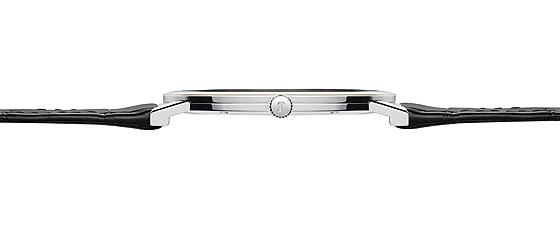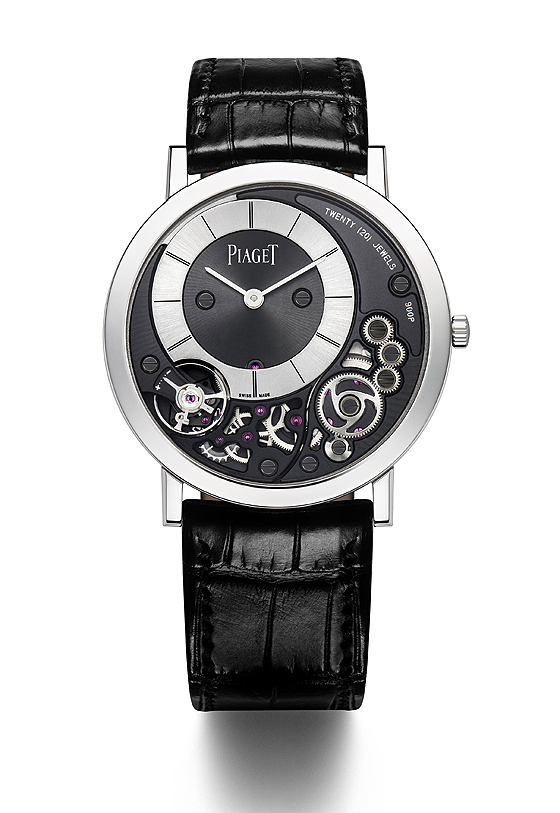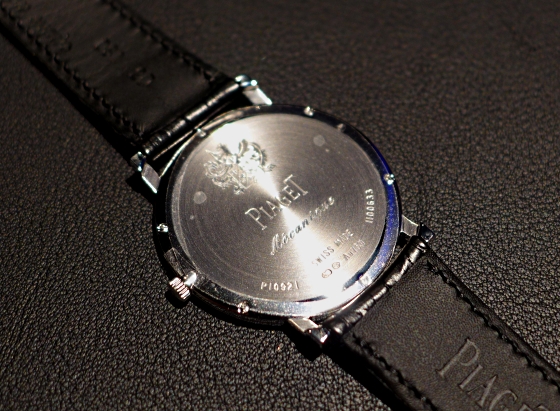For more than half a century Switzerland’s Piaget Mens Replica has specialized in manufacturing ultra-thin mechanical replica watches and replica watch movements. Now it has produced what it says is “the thinnest mechanical replica watch ever.” The new Piaget Altiplano 900P has a total case thickness of 3.65 mm, 9.9 percent less than the thinnest mechanical replica watch currently on the market, the 4.05-mm-thin Jaeger-LeCoultre Master Ultra-Thin Jubilee.
The Piaget Altiplano 900P Replica Watch has an 18k-gold case when the replica watch reaches stores in 2014. The replica watch was formally unveiled at the SIHH exhibition in Geneva this week; Piaget presented press previews of the replica watch in December.
Piaget accomplished its world-first by employing an ingenious, radical engineering solution. It “merged” the caliber with the case, using the caseback to serve as the mainplate. The result is that the replica watch does not have an independent movement that can be removed from the case. The mainplate is machined out of the caseback. This procedure gives the replica watch its extraordinary thinness. It is the same principle behind the construction of the famous ultra-thin Concord Delirium replica watch, which set a world record for thinness in 1979. The Delirium was a quartz replica watch whose total thickness was 1.79 mm. A later version, Delirium IV, was thinner than a millimeter; the replica watch was an astounding 0.98 mm thick. The same caseback-as-mainplate principle is used in quartz Sreplica watch replica watches. Piaget is the first to apply the principle to mechanical replica watches.
The replica watch’s unorthodox internal architecture and the need for maximum thinness required Piaget to make technical changes that give the replica watch its unusual design. Using the caseback as a mainplate forced Piaget to reverse the traditional movement construction and make the bridges part of the replica watch’s dial. Hence, the entire wheel train is visible on the dial. Among the technical innovations is a barrel suspended from a single bridge on the dial side as opposed to the traditional spot fixed to the mainplate.

The replica watch took three years to make, Piaget says, and required closer-than-usual coordination between a team of replica watchmakers, case constructors and designers. The entire replica watch was designed and produced in house at Piaget’s two Swiss plants — the movement facility in La Côte aux Fées in the Swiss Jura Mountains and the factory at Plan-les-Ouates outside Geneva, where it produces cases. The Piaget team sought to save space wherever it could in the 145-part replica watch. Some wheels measure 0.12 mm thin, for example, compared to 0.20 mm in a classic movement. To save an additional few millimeters, the entire mechanism and the hand-fitting system are contained within the thickness of the balance wheel itself (and led to the off-center placement of the hours and minutes display).
Piaget says it has solved the problem that plagues extremely thin replica watches: their tendency to bend slightly under pressure. The Delirium replica watches, for example, were so thin that merely strapping them on the wrist bent the rectangular case slightly, causing the crystal to press against the hands, stopping the movement. To avoid such problems, Piaget’s construction places the hands at a level below the bridges that surround the hour and minute display, creating space between the cannon pinion and the crystal. Should the crystal bend from the effects of pressure, it presses on the wheel-train bridge, not the hands, with no impact on the timing mechanism. A Piaget patent for this solution is pending.
The 900P gets its name from Calibre 9P, Piaget’s first ultra-thin hand-wound movement, which was introduced in 1957. Many more ultra-thin movements followed. Of the 35 total movements Piaget has developed and produced in house, 23 are ultra-thin. Twelve of the 23 ultra-thin movements have set records and are currently in production.

